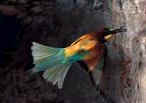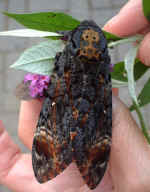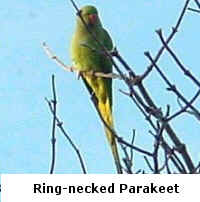| BIRDWATCH IN COOKHAM |

OCTOBER
2003
Winter
Draws On
After so many weeks of dry and warm weather, we were reminded of the season at the beginning of October by a blast of cold and windy weather. The birds responded immediately with a mass withdrawal to warmer climes. Swallows and House Martins moved off quickly and the last warblers were not far behind them. Probably the most common warbler left around of late has been the Chiffchaff, with hundreds moving through the county from northern England, heading for the south coast and feeding up as they go past us here in the Thames Valley.
Small birds have to double their weight before tackling long migration journeys, which they do by taking on lots of fat to provide the energy they need. This means a typical small warbler weighing in at 17 grams needs to get up to 34 or so prior to setting off.
Of course, it is not just birds departing at this time of year; we also get birds arriving and the winter thrushes I mentioned in the last report are already coming in. Fieldfares from northern Scandinavia were on the east coast by September and the first one reached Berkshire (Twyford) two weeks ago. The first Redwings were over Cookham this week (6th October) with a steady movement of birds moving northwest.
 Birds
of special interest around the village this month have included a
return of the Peregrine Falcon over Widbrook, causing havoc
amongst the crows and pigeons. Most interesting however
has been a Lapland Bunting which turned up in the stubble
fields south of Lightlands Lane. This bird will have spent the summer
breeding on the tundra and open mountains of northern Scandinavia and
Russia and will have wandered off its migration route to southern
Europe for the winter. They quite often occur on eastern estuaries of
England but are less regularly found at inland locations, with only
about fifteen records in Berkshire this century. Birders from quite
far afield came to admire the Bunting, including the well-known
Lee Evans, who readers may have seen on TV in a documentary about
twitchers.
Birds
of special interest around the village this month have included a
return of the Peregrine Falcon over Widbrook, causing havoc
amongst the crows and pigeons. Most interesting however
has been a Lapland Bunting which turned up in the stubble
fields south of Lightlands Lane. This bird will have spent the summer
breeding on the tundra and open mountains of northern Scandinavia and
Russia and will have wandered off its migration route to southern
Europe for the winter. They quite often occur on eastern estuaries of
England but are less regularly found at inland locations, with only
about fifteen records in Berkshire this century. Birders from quite
far afield came to admire the Bunting, including the well-known
Lee Evans, who readers may have seen on TV in a documentary about
twitchers.
If your bird feeders have been used during the summer, now might be a good time to clean them before the winter takes a hold and dependency upon them increases. If you haven’t fed the birds during summer, then now is the time to commission your feeders into use.
SEPTEMBER
2003
What a summer! Weeks of dry conditions, hottest temperatures on record. What has all this meant for our local birds? Well, after a poor start when a cool and damp spring decimated early broods for birds such as Blue Tits (remember cool and damp?), breeding went on apace and many species did well. Summer Warblers arrived on time (which itself is about two weeks earlier than used to be the case) and soon started nesting. Whitethroats bred along Strand Water and on Winter Hill, but one determined male sang his heart out in Alleyns Lane for nine whole weeks without attracting a mate. Both Reed and Sedge Warblers bred along Strand Water and the usual three pairs of Sand Martins once again took up their drainage pipe nest holes in the brick wall above the stream in front of the Odney Club.
House Martins returned but, for the first time for years, did not breed on the Broomhill Estate. The remaining pair from last year did inspect their nest in the third week of May but never re-used it. Perhaps they all bred elsewhere in the village? I would be grateful to hear from anyone who had them on their house for the first time. ‘Our’ Ring-necked Parakeets were very noisy this summer, but also did not breed in their usual place. This may be because of one of the highlights of the year – a pair of Hobbies bred on the outskirts of the village, right where the Parakeets often set up home. This once-rare bird of prey only visits for the summer and not many years ago there were only about 100 pairs across the nation. They have done well in recent years and young birds form the previous year are always looking for new territories, and this year, Cookham was selected. Little Owls did well and at least 2 pairs of Tawny Owls used the boxes in Quarry Woods, as did 2 pairs of Mandarin.
Moorhen continue to be scarce along the edge of the golf course and elsewhere, doubtless due to the continued damage being caused by Mink. Red Kites still make daily forays over the village and Buzzards have been seen increasingly too. Sunday Sep 7th transpired to be a major day for raptor movements with at least 6 Buzzards migrating south over Widbrook, including one possible Steppe Buzzard, the eastern European race of the bird. Whilst all that was happening, a Kite was being mobbed by a Hobby, as was another Buzzard over Odney, a Peregrine was over Winter Hill and a family party of four Buzzards were diving and talon-grappling over Cockmarsh – quite a spectacle on a bright sunny morning.
 A
fascinating report came in of a Bee-eater on the bridge
hand-rail at Odney Club in late August, but it had disappeared before
local birders could get on site. A current activity few in the village
could fail to have noticed is the daily routine of the local geese
assemblage. A huge mixed flock of geese, comprising about 400 Canadas,
100 Greylags, no less than 75 Egyptian Geese (a national
record!), 4 Bar-headed, 1 Barnacle and John Copas’
wandering Ross’s Goose have all set up in Switch-back Road
fields, whilst there is still stubble to feed on. Their routine is to
arrive there early in the morning and then fly off to Marlow about an
hour after dawn. In the evening they are there again, setting off at
dusk in skeins of around fifty birds. This will probably go on until
the inevitable ploughing and autumn crop sowing which will bring their
feeding bonanza to an end.
A
fascinating report came in of a Bee-eater on the bridge
hand-rail at Odney Club in late August, but it had disappeared before
local birders could get on site. A current activity few in the village
could fail to have noticed is the daily routine of the local geese
assemblage. A huge mixed flock of geese, comprising about 400 Canadas,
100 Greylags, no less than 75 Egyptian Geese (a national
record!), 4 Bar-headed, 1 Barnacle and John Copas’
wandering Ross’s Goose have all set up in Switch-back Road
fields, whilst there is still stubble to feed on. Their routine is to
arrive there early in the morning and then fly off to Marlow about an
hour after dawn. In the evening they are there again, setting off at
dusk in skeins of around fifty birds. This will probably go on until
the inevitable ploughing and autumn crop sowing which will bring their
feeding bonanza to an end.
As
we approach the shorter days, gull numbers will build up in places
like Alfred Major Recreation Ground and on the pick-your-own fields.
The most usual species is Common Gull which, despite its name,
is not as common as Black-headed or Herring gull. Incidentally,
both Herring and Lesser Black-back Gulls bred in Bucks for the
first time this year, on roofs of factories in High  Wycombe. So, we have said farewell to most of the summer visitors, but
the size of the crop of Elder and Hawthorn berries suggests there will
be plenty of food available for the Redwings and Fieldfares when
they get to us. The first Fieldfares have already arrived on
the east coast and they will be hoping for improved pickings compared
with last year when the gale of October 29th stripped many
bushes and hedges of the fruit before the winter thrushes got
to them.
Wycombe. So, we have said farewell to most of the summer visitors, but
the size of the crop of Elder and Hawthorn berries suggests there will
be plenty of food available for the Redwings and Fieldfares when
they get to us. The first Fieldfares have already arrived on
the east coast and they will be hoping for improved pickings compared
with last year when the gale of October 29th stripped many
bushes and hedges of the fruit before the winter thrushes got
to them.
In passing, it has also been an exceptional year for Humming Bird Hawk Moths? Did you see any? Please let me know. I found 6 in various places, including one in our conservatory, and an even more impressive Death's Head Hawk Moth in my spud crop in Alleyns Lane. Eyes to the Skies.
April 2003
Well
into April and summer migrants are trickling into the country. First
Swallows and House Martins were in fact around a month
ago, but subsequent changes in wind direction held up the main
arrivals until this week. Cuckoo has been heard in  Berks
and the first Hobby was over Cookham on Sunday. The regular Red
Kite is still visiting the village daily and there were up to 4 Buzzards
over the Dean earlier today (15th).
Berks
and the first Hobby was over Cookham on Sunday. The regular Red
Kite is still visiting the village daily and there were up to 4 Buzzards
over the Dean earlier today (15th).
Other
summer warblers such as Whitethroat, Sedge Warbler and Tree
Pipit are all on station in their preferred habitats in the
county, and the first Nightingales have been heard singing this
week in the Kennet and
Resident
species are already breeding, with several Tit nest boxes
reported as being in use. Mute Swans, Coots and Moorhens
are also nesting on the
Little Owls were in at least four of the local nest boxes and several have yet to be checked. Similarly, Tawny Owls had eggs in one box and three delightful two-day old chicks in another. The good weather forecast for the days leading up to Easter is sure to encourage a major rush of migrants into the country, so keep your eyes open for any that might visit your garden this weekend.
January 2003
Another Christmas gone; another year started, and the new season brings with it an exciting but challenging time for our birds. As soon as the day-length starts to draw out, birds are the first to detect it and their natural response is to prepare for the breeding season ahead. For some birds, this means now! Herons and Rooks will already have created their nests and may have eggs in them, and Tawny Owls will not be far behind them, in places such as Quarry Wood. Woodpigeons too may already be building their simple nests and their relatives, the Feral Pigeons are also notoriously early breeders. My neighbour found a nest with a two-week old chick just this week!
Other species such as Dunnocks and Robins have been pairing up and singing their love sonnets to each other and male Blackbirds have been getting very aggressive towards their cousins which have muscled in for the winter and threaten to grab all the food going. The resident males are the all-black ones with distinctive yellow bills and eye-rings; the ‘foreigners’ from Scandinavia lack the yellow tones, but will gain them by the time they get back to their own country. Song Thrushes have also begun singing in their chosen territory, but the song is still hesitant and not yet very creative. It will soon be at full strength throughout February and March, by the time the first migrants arrive from Africa.
But it is still a time of challenge for all these species and many others. The recent flooding will have totally disrupted feeding habits with many sources of essential food covered in water for weeks, (although it was interesting to see Teal, Gadwall and Mallard ducks swimming around where fields would normally be). Then the frosts came and froze the ground too hard for birds to turn to foraging for sub-terranial invertebrates. This has had a dramatic effect on winter thrushes such as Fieldfares and Redwings, which were in huge numbers around the village last winter, but are hardly to be found at present.
However,
the number of Blackcaps has been fairly typical. These
delightful ‘summer’ warblers have increasingly been found
over-wintering in recent years, possibly coming to us from Germany and
Austria to sample our milder winters, feeding in gardens on fruit and
off bird tables. There have been up to 3 females and 1 male in our
small garden alone, and a pair have been active in High Road. I found
a much rarer bird in Cookham just before Christmas, a juvenile Little
Gull, usually a coastal  bird
and occasionally seen on large reservoirs. This one fed on farmland
adjacent to Widbrook Common for a bout a week, creating a major focus
for birdwatchers from around the county.
bird
and occasionally seen on large reservoirs. This one fed on farmland
adjacent to Widbrook Common for a bout a week, creating a major focus
for birdwatchers from around the county.
Red Kites are not so prominent yet, but sightings will increase from about March onwards as non-breeding first-year birds spend the summer wandering around and checking prospective nest sites for the following year. The Ring-necked Parakeets have been regular visitors to gardens in School Lane and, up to the floods, Little Owls had been doing well behind CIM and on White Place Farm; but feeding will have been difficult for them recently with so much water in the area. Across the river, Cormorants have been seen displaying and carrying twigs, potentially the first time the species will have bred in the area.
The next ‘big’ thing on the birding calendar is the Big Garden Birdwatch, this coming weekend on 25th/26th January. The idea is to choose a one hour period over that weekend to sit and look out, recording the numbers of each species seen during that time. Sponsored by RSPB, this is not only fun, and educational for the children, but the statistics provide important information on how our garden birds are faring, and there is a special web site on www.rspb.org.uk/birdwatch on which to get further information and into which to record your sightings. Otherwise, by all means e-mail the results to me (BCS@birdbooks.org.uk) and I’ll forward them on. Do get involved.
|